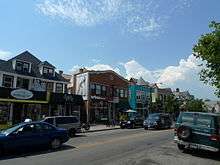Neighborhoods of Buffalo, New York
Buffalo consists of 31 different neighborhoods, over an area of 52 sq. mi The following is a list of neighborhoods defined by the University at Buffalo.[1]

Allentown
Black Rock
See also Market Square Historic District.
Bailey-Lovejoy
Central Park
Cold Springs
Delaware District
See also Delaware Avenue Historic District.
Downtown
See J.N. Adam-AM&A Historic District; Canalside District, Buffalo; Buffalo Theater District
East Side
Elmwood Strip
The American Planning Association named the Elmwood Village neighborhood in Buffalo one of ten Great Neighborhoods in 2007.[2] Elmwood Village[3] is a pedestrian-oriented, mixed use neighborhood with hundreds of small, locally owned boutiques, shops, restaurants, and cafes. The neighborhood is located to the south of Buffalo State College.
See also Elmwood Historic District–West.
Fillmore-Leroy
First Ward
Fruit Belt (Medical Park)
Hamlin Park
The Hamlin Park Historic District was listed on the National Register of Historic Places in 2013.[4]
Hospital Hill
Humboldt Park
Kaisertown
Kensington
Lower West Side
See West Village Historic District and Fargo Estate Historic District.
Masten Park
North Buffalo
North Park
Parkside
See Parkside East Historic District and Parkside West Historic District.
Polonia
Riverside
Schiller Park
South Buffalo
South Buffalo, which was split by the construction of Interstate 190 during the 1950s, is troubled by the presence of a concrete crushing facility which is grandfathered in as a pre-existing use, while dust and truck traffic from the facility strongly affect residences in the neighborhood.[5]
University District
University Heights
Vernon Triangle
West Side
See also Fargo Estate Historic District, West Village Historic District.
Willert Park
References
- "City of Buffalo - Neighborhoods". Archived from the original on 2015-09-26. Retrieved 2015-09-26.
- "American Planning Association". Retrieved October 4, 2007 Archived October 11, 2007, at the Wayback Machine
- "Forever Elmwood – The Elmwood Village Association". Foreverelmwood.org. Archived from the original on August 10, 2013. Retrieved August 1, 2013.
- "National Register of Historic Places Listings". Weekly List of Actions Taken on Properties: 7/08/13 through 7/12/13. National Park Service. 2013-07-19.
- "Buffalo’s decade-long dust bowl" article by Dan Telvock in Investigative Post April 3, 2014 Archived April 7, 2014, at the Wayback Machine
